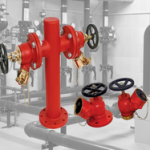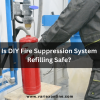![]()
Fire Immuniser
+91-7829629111
Email: info@variex.in
Varistor Technologies Pvt. Ltd.
Block-1, First Floor, Ardente Office One, Hoodi Circle, ITPL Main Road, Bengaluru, Karnataka 560048, IN
What Are Equipments In Fire Hydrant System
A fire hydrant system is a vital part of any building's fire safety infrastructure, providing quick access to water for firefighting purposes. Below is a detailed explanation of the key components within a typical fire hydrant system:
- Hydrant: The hydrant itself is the most recognizable component of the system. Typically located outdoors and connected to a pressurized water source, the hydrant features an above-ground outlet to which hoses can be attached.
- Valves:
- Main Control Valve: This valve regulates the flow of water into the system from the main water supply. It is typically located underground and is operated by trained personnel during emergencies.
- Outlet Valves: Found at each hydrant, these valves control the flow of water to individual hoses. They can be opened and closed as needed to direct water to specific areas.
- Main Control Valve: This valve regulates the flow of water into the system from the main water supply. It is typically located underground and is operated by trained personnel during emergencies.
- Pipes: A network of underground pipes distributes water from the main supply to the hydrants. These pipes are typically made of durable materials such as ductile iron or steel to withstand high pressures and corrosion.
- Couplings: Couplings are connectors that join hoses to hydrants and other firefighting equipment. They are designed to be leak-proof and provide a secure connection to maintain water pressure during firefighting operations.
- Hose Reels: Hose reels are storage devices for fire hoses, allowing for quick deployment in the event of a fire. They can be either fixed in place or portable and are often located indoors near fire exits or high-risk areas.
- Nozzles: Nozzles are attached to the ends of fire hoses and control the direction and flow of water. They come in various types, including adjustable spray nozzles for general firefighting and solid stream nozzles for long-range applications.
- Pressure Gauges: Pressure gauges are instruments used to measure the water pressure within the system. Firefighters rely on these gauges to ensure that an adequate water supply is available and to monitor pressure levels during firefighting operations.
Fire Department Connection (FDC): The FDC provides a point of connection between the fire hydrant system and the municipal water supply. It allows firefighters to supplement water from the hydrant system with high-pressure water mains, increasing firefighting capabilities.
Advantages and Disadvantages of Fire Hydrant System
| Advantages | Disadvantages
|
|---|---|
| Rapid access to water for firefighting. | Installation and maintenance costs can be high. |
| Provides a reliable and pressurized water supply during emergencies. | Relies on municipal water supply, which may be limited during certain situations (e.g., drought).
|
| Helps prevent the spread of fires and minimizes property damage. | Requires regular inspection, testing, and maintenance to ensure functionality.
|
| Enables firefighters to quickly deploy hoses and extinguish flames. | May be subject to vandalism or tampering, compromising effectiveness.
|
| Enhances overall fire safety measures in buildings and communities. | Limited coverage area based on the placement of hydrants.
|
| Can be integrated with other fire protection systems for comprehensive safety. | Requires trained personnel to operate valves and maintain the system.
|
Understanding the function and importance of each component within a fire hydrant system is crucial for effective fire safety planning and maintenance. Regular inspection, testing, and maintenance of these components ensure that the system remains reliable and ready to protect lives and property in the event of a fire.
Frequently Asked Questions
Responsibility for maintaining fire hydrant systems often falls on property owners, building managers, or designated maintenance personnel. Regular inspections and maintenance should be conducted to ensure compliance with regulations and uphold fire safety standards.
Yes, regulations regarding the installation, maintenance, and operation of fire hydrant systems vary by jurisdiction and are typically outlined in local building codes, fire safety standards, and municipal ordinances.
If you encounter any issues with a fire hydrant system, such as leaking hydrants, damaged pipes, or malfunctioning valves, it is important to report them to the appropriate authorities or property management promptly. Timely repairs and maintenance help ensure the system's effectiveness in emergencies.
While the primary purpose of fire hydrant systems is firefighting, they may also be used for activities such as street cleaning, construction, or filling water tanks. However, such uses should not compromise the system's availability during emergencies.
Fire hydrant systems play a critical role in fire safety by providing a reliable water supply for firefighting efforts. They help prevent the spread of fires, minimize property damage, and protect lives.
Final Say
At VariEx.in and VariexOnline.com, we specialize in supplying and installing top-quality fire fighting systems and equipment. From fire extinguishers to advanced suppression systems, we offer comprehensive solutions tailored to your needs. Our experienced team ensures precise installation and maintenance for optimal safety.
Trust VariEx for reliable fire protection. Contact us online or call 7829629111 to learn more.









